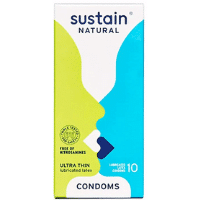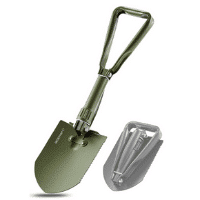What if the worst happens and you find yourself in an emergency situation on one of your camping expeditions?
Knowing what to put in a survival backpack could potentially save your or your loved ones' life.
According to a study that analyzed over 100+ news reports, the most common reason for people requiring search and rescue is that they wander off the hiking trail and essentially get lost. Some of these people were missing from half a day up to 90+ days.
Based on this information I'm sure you see that in the worst case scenario you may have to be prepared to survive for 90+ days. It's under these circumstances that knowing how to navigate with nature and having the right survival gear in your backpack could indeed save your life!
(Please note: The opinions expressed in this publication are those of the author. They do not purport to reflect the opinions or views of Bluetti Power Inc. or its members.)
Keep it Dry
Before we even begin to think about what to put in a survival backpack, we need to make sure our backpack is waterproof.
I don't care if a top of the range backpack manufacturer claims that their backpack is 100% waterproof, they never are. At least they won't be if you are forced to wade through a lagoon or an underground river.
This is why I always recommend you invest in a waterproof backpack liner of some sort. Once you've done that, you'll need another one. One liner is never enough in water!
I've lost count of the number of people I know who trusted their phones in a "waterproof" backpack, only to find that its not waterproof at all.
What to put in your survival backpack?
Once you've double lined your backpack, you can begin to think about what to put in it.
Remember with a light pack on your back, you will move with more speed and agility over rough terrain.
This way you can make sure that your energy is used for the right reasons, rather than lugging around an extremely heavy backpack.
Your complete survival kit must contain only the essentials.
Knife
As the saying goes, "pack a knife save a life". If you were to take only one bit of kit on an outdoor expedition, it should be a knife. Check out all the uses for a survival knife.
Emergency Rations
At the bottom of your backpack you should always carry some emergency rations. A good stash would include, nuts, energy bars and flapjacks. Put the stash at the bottom of your bag and forget about it, hopefully not, but one day it may come in handy.
Survival Straw
These straws are plastic tubes with built in filters that do all the hard work of purifying water for you. You can use this straw to suck up water from a puddle, a river or a bottle. The lifestraw removes 99.9999% of waterborne bacteria. I often carry one of these in my survival backpack.
Warm Clothing
Clothing can make a backpack heavy, fast. You don't want to carry too much unnecessary clothing. The most essential item to have is a waterproof jacket, it gives you that extra layer of protection from the elements. A good jacket, has waterproof zips, velcro cuffs and an elasticated hem.
Map
Make sure to get a map of the area you plan on hiking in, especially if you plan a multi-day hike in an area you are unfamiliar with.
Compass
A compass is always going to be one of your closest friends, as far as survival equipment goes. It doesn't need to be big fancy or expensive, as long as it works you are all set and ready to go.
Two Metre Length of Rope
Rope has many uses like:
- Building shelters
- Fishing
- Kit repair
- Emergency tourniquet
- Shoelace
Check out the Titan Survivorcord, it is extremely light yet extremely strong and has many uses.
Head Torch
So many people get in trouble when getting lost at night without a light source. A head torch shows you the way and keeps your hands free at the same time. Remember to stock up on spare batteries.
Can of Spray Plaster
You will only need a small can. The cool thing about these, is they are an antiseptic as well as being able to seal any small cuts you get while in the outdoors.
Waterproof Matches
I wouldn't rely on lighters in a survival situation, they easily stop working when wet. Matches are your best option for starting a fire in difficult conditions.
Nine Volt Battery and Steel Wool
In case your matches stop working for some reason, a good backup would be a 9-volt battery and some steel wool. Check this website out to see the steps involved.
Tea Light
These little guys come in handy in many situations. In particular, inside of snow caves. One candles light can reflect against the snow and brighten up the entire cave for you. They are also a good indicator on the oxygen levels. If it starts flickering, you need to make another hole in your snow cave.
Condom
These take up almost zero space and can hold upto 2 litres of water. They are also waterproof, perfect for keeping any tinder you have gathered dry. Also, you can use them as an improvised glove for when you are treating wounds you don't want to infect.
Survival Spade
Perhaps one of the less important things you need to put into your survival backpack. Nevertheless a spade can really come in handy, especially if you plan on traveling to areas with snow. This spade I've featured below folds up really small and only weighs 1.15kg/2.5lbs.
What To Put in a First Aid Kit?
My survival backpack carries my complete survival kit and first aid kit together. For both kits I prioritize portability/weight. I don't want to be bogged down by my survival backpack. Therefore there's no room for luxuries, I only carry the absolute essentials for if I ever find myself in a emergency situation.
Gaffer Tape
It's the same as duct tape, except it doesn't leave any sticky residue behind upon removal. The tape has loads of uses, it can strap peoples feet together if they have a broken bone. You can seal a wound that needs stitches or even stick it over sucking chest wounds to aid breathing. You can even use it as an eyepatch. The list really does go on and on, check this site to see a few more uses for gaffer tape besides medical ones.
Quikclot
Quikclot is a product used by many hospitals, first responders and military around the world. It is used to deal with catastrophic bleeding injuries. Originally quikclot was a powder which you would pour into the wound, today the modern version comes in a form of gauze. It is much lighter and clots up a wound seriously fast. How it works is you push the gauze into the wound, whether it be a animal bite, severed arm or bullet wound - to stop the bleeding and clot the bleeding super quick.
Oropharyngeal Airway
This is a plastic tube which you use to put down the patient's mouth, it helps to keep their airway open. It does this by stopping the tongue from falling back and covering the epiglottis, which is fairly common when someone falls unconscious (these are not used when patients are conscious as it stimulates the gag reflex and would probably make them throw up). You could also look into a nasal airway, these fulfill a similar function except are inserted through the nostril, not the mouth.
Asherman Chest Seal
These are a special type of dressing used on traumatic chest injuries. They allow blood and air to escape but do not allow anything back inside.
Tourniquet
Standard first aid advice is to avoid the use of tourniquets. However, in extreme environments where your survival depends on stemming the bleeding - tourniquets may just come in handy. Take for example the story of Aron Ralston, who had to cut his own arm off to survive. Without the use of makeshift tourniquet it is very likely that he would of died.
Epipen
If you are allergic to bees or to any other type of stimuli, a shot of adrenaline could potentially save your life from life-threatening anaphylactic shock (always consult your doctor on the right medication needed).
Zinc Oxide Tape
I love zinc oxide tape, I use it on my fingers when bouldering. The tape acts as a layer of protection so that you don't tear the skin while climbing. However, the tape can also be used for blister prevention around the heels and toes. If you have ever walked in a new pair of shoes before and gotten a blister I'm sure you know the pain a simple tiny blister can cause. Once in Laos I got a tiny blister from walking all day, it got infected and caused my whole foot to swell up, I couldn't even walk on it anymore. Zinc Oxide tape can help prevent blisters from forming at all.
Complete First Aid Kit
If you don't want to build your own first aid kit (recommended) you can also look into buying a complete first aid kit then taking out the essentials to put into your survival backpack. Check out this first aid kit, they have most of the essentials.
Rule of Threes
What is the rule of threes? Well, simply put the rule of threes is how long you can survive without these four basic necessities:
- Without Air - 3 Minutes
- Without Shelter - 3 Hours
- Without Water - 3 Days
- With Food - 3 Weeks
These numbers are averaged out and of course vary slightly person to person. This rule teaches you what to prioritize when you find yourself in a emergency situation. Based on the rule of threes it makes no sense for example, to look for food if your freezing and haven't built or found a shelter yet.
I hope after reading this post you have a much better idea of what to put in a survival backpack.
You will find many lists on the internet which really go overboard and to be honest, you would probably need a trailer to lug everything around. Our survival backpack list comprises of only the essentials.
This insures that your backpack will be lightweight on your back, but will include everything you'll need in an emergency situation.






















































































